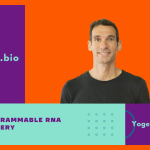Alta is transforming how revenue teams work by combining AI automation with deep operational insights. Founded by Stav Levi Neumark, who helped build Monday.com’s internal BI system, Alta streamlines sales and RevOps with AI agents that handle research, outreach, and analysis, freeing human teams to focus on strategy and relationships.
1. What inspired the creation of Alta, and what problem were you aiming to solve?
Stav Levi Neumark: I was one of the first employees at Monday.com. and my first project was developing a BI tool we called “BigBrain”. I got to work with the CEOs to build the product, which analyzes business data to help revenue teams understand their operational landscape. This tool became central to almost every business decision at Monday.com and played a significant role in helping the company grow to over a billion dollars in annual revenue.
Over the years, lots of companies reached out and asked for help developing their own version of Monday’s BigBrain. Seeing the interest from so many companies reinforced what we believed – with the right data, teams can make significantly better operational decisions. The idea forAlta comes directly from that understanding.
We also noticed that while AI is transforming nearly every industry, revenue and go-to-market teams struggle to fully harness the potential of AI. Teams waste valuable time on repetitive tasks, data silos prevent a zoomed out understanding of the revenue pipeline, and human talent is wasted on administrative work instead of relationship-building.
Alta addresses these challenges with its data-driven AI revenue workforce. Our AI agents automate mundane tasks, like researching potential leads and conducting personalized outreach across multiple channels. We also provide actionable insights based on real-time data across all revenue functions.
Our mission is to help people in sales become the best version of themselves through AI—literally 10X themselves—and as a result, help companies increase sales. We want to eliminate small, repetitive tasks from revenue teams’ workflows and enable them to focus on what they’re best at, like sales and creating connections between people. The agents in our workforce are driven by large amounts of data so they can make the best impact possible.

2. How does Alta’s AI-driven revenue workforce redefine traditional sales and RevOps functions?
Stav Levi Neumark: Alta’s AI-driven revenue workforce establishes unprecedented alignment between departments. We break down silos between sales, marketing, and customer success by connecting their data into a unified view of the customer journey.
We establish a “build-measure-learn” loop that connects strategy with execution. Teams can quickly test approaches, measure results, and refine strategies based on real-time data and insights.
Our platform ensures teams focus exclusively on high-ROI activities by automatically identifying and prioritizing the most promising opportunities. This means sales professionals target prospects with the highest conversion potential rather than spreading efforts thinly.
Most importantly, by automating mundane tasks like data entry, lead research, and follow-up sequences, Alta frees up significant capacity for creative, strategic work. Revenue teams don’t just work faster—they work fundamentally differently, concentrating their human capabilities where they add the most value with AI taking care of the rest.
3. What were the biggest challenges in developing AI-powered SDRs and RevOps automation?
Stav Levi Neumark: The biggest challenges in developing AI-powered SDRs, sales agents and RevOps agents came from connecting as many data sources as possible and transforming that data into strategic insights that actually drive conversions. We had to integrate with dozens of systems to create a comprehensive view while developing sophisticated models that could determine who, when and how to target – and with what messaging – to maximize response rates.
Unlike tools that automate existing processes, we needed to completely overhaul the sales development approach to leverage AI’s capabilities while making sure that we left space for the human touch that closes deals. Finding this balance between automation and personalization required constant iterations based on real-world performance data.
4. How has your experience in securing funding and partnerships influenced Alta’s growth trajectory?
Stav Levi Neumark: We were really privileged in our experience securing funding. I had previously assessed some companies for Target Global through my role at Monday.com and Entrée Capital was the first VC that invested in Monday.com. We had a lot of interest from a number of VCs, but we knew we wanted to work with Target and Entrée. Having already worked with them, we knew what interested them and how they viewed the growing need and pain points that AI could address for industry.
Our current growth phase reminds me of a similar time at Monday.com. It’s really exciting, and you’re a part of growing a product that has really big demands and many people are excited about it. We also see some very happy customers. At the same time, we are working really intentionally and are thinking carefully about our next steps in order to build and grow in a very healthy way, avoiding as many big mistakes as possible along the way.
5. Can you explain how Alta’s AI platform optimizes revenue operations through automation and data insights?
Stav Levi Neumark: Alta leverages data and AI to drive business growth 24/7 by completing tasks such as building an outbound pipeline and qualifying inbound leads via calls. This frees up sales teams to close deals, and deliver insights across all revenue functions.
6. What makes your AI SDR and AI Calling solutions unique compared to traditional sales engagement tools
Stav Levi Neumark: Our AI SDR agent and AI calling agent are built on a foundation of data, constantly analyzing and refining sales strategies to ensure the right messaging reaches the right person. By leveraging vast amounts of data, our AI agents are able to identify and target the ideal ICP with precision, delivering highly relevant and personalized outreach. It’s different from traditional sales tools because our AI solutions are designed to continuously improve, ensuring that sales teams get the most efficient, data-driven insights and strategies. Our AI agents are transparent about being AI, which actually allows them to build trust and engage effectively with prospects, optimizing sales and RevOps efforts.
7. How do you see AI reshaping the future of revenue teams and sales efficiency?
Stav Levi Neumark: We see AI as the catalyst behind revenue teams that empowers employees to be the “10X” version of themselves. When AI agents are trained to complete grunt work, human revenue teams have the ability to focus on creative tasks.
Looking forward, we predict that AI teams will become fully integrated across organizational departments. With this trend in mind, we’re currently developing agents in account executive and account management roles as well.
8. What are the main benefits for businesses integrating Alta’s AI-driven revenue agents?
Stav Levi Neumark: The bottom line is that by integrating Alta’s AI-driven revenue agents, companies can benefit from a bigger pipeline and more revenue. By automating mundane and repetitive tasks, businesses can save time, allowing sales teams to focus their efforts on closing deals. Alta’s AI agents are also designed to identify and engage with the best ICP, so every interaction is strategically aligned to drive results. Time saved, targeted outreach, and increased efficiency lead to higher win rates and ultimately more revenue, making the sales process more effective and profitable.
9. What challenges have you faced while scaling Alta, and how did you overcome them?
Stav Levi Neumark: The biggest challenge we’ve faced while scaling Alta has been maintaining balanced and healthy growth. It’s tempting to let one area develop disproportionately – whether that’s sales outpacing product capabilities or engineering moving faster than customer success can support.
From my time at Monday.com, I learned the critical importance of “harmonious scaling”. We’ve been deliberate about not overselling features the product can’t deliver yet, even when it means saying no to opportunities that might boost short-term numbers.
We’ve also implemented cross-functional planning to ensure all departments grow relative to one another. Sometimes this has meant slower growth, but it’s created a more sustainable foundation with consistent customer experiences and our team isn’t constantly putting out fires.
10. Looking back, are there any strategic decisions you would approach differently now?
Stav Levi Neumark: Looking back, I might approach market monitoring and adaptation differently. The market and technology landscape are constantly changing, and I would focus more on predicting where it’s going next,and acting faster when adapting.
Being more proactive to market shifts would have allowed us to position ourselves ahead of some trends. When we’re so focused on product development and customer acquisition, it’s easy to miss emerging signals from the broader ecosystem. Most established processes for regular market analysis would also have helped identify opportunities earlier and given us a chance to respond faster.
11. What does success look like for you and Alta in the next 5–10 years?
Stav Levi Neumark: Success for Alta in the next 5-10 years is about seeing our customers achieve company-changing results.I envision our customer base benefiting from enormous value from our AI agents, with each customer experiencing significant growth while operating with extreme efficiency.
Our customers are our number one priority, and true success means becoming an indispensable part of their revenue operations. I want Alta to be the force that enables companies to scale their revenue teams without proportionally scaling headcount or complexity.
Beyond just helping them operate more efficiently, success means our customers attribute significant revenue growth directly to our platform. When they look at their business results and can clearly see Alta’s impact on their bottom line, that’s when we’ll know we’ve really succeeded.
12. What does a typical day in your life as a founder look like, and how do you stay motivated?
Stav Levi Neumark: A typical day doesn’t really exist. Instead, I have created anchors that keep me grounded. My day starts early with my 4-month-old daughter and always ends with dinner with my husband. These personal moments give me stability when I’m constantly working to meet the changing demands of building Alta.
Otherwise, I’m wherever the business needs me most. As the company evolves and grows, my focus shifts accordingly, from product development to sales, customer success to marketing. The needs change as we grow, and my role adapts to address the most critical areas requiring attention.
The constant changes keeps things interesting and challenging for me. Instead of a strict schedule, I’ve had to learn how to be flexible and respond to current priorities while keeping an eye on the crucial personal touchpoints that keep me motivated and balanced.
Editor’s Note
Stav Levi Neumark’s vision for Alta is about more than automation—it is about empowering revenue teams to perform at their highest level. In this interview, she shares how AI can unlock new levels of efficiency, creativity, and growth across sales organizations.
Discover more interviews with AI founders on the AIPressRoom Interviews page.



